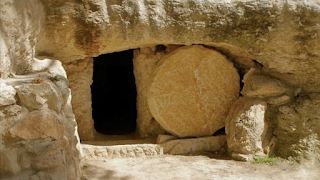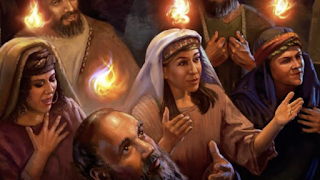In this two-part article I will explain the first and second resurrection and the period in between.
Let’s begin in Revelation 20
6 Blessed and holy is he that hath part in the first resurrection: on such the second death hath no power…
The fact this verse mentions the “first” resurrection, suggests there’s more than one.
Further down this same chapter we see the second resurrection described.
12 And I saw the dead, small and great, stand before God; and the books were opened: and another book was opened, which is the book of life: and the dead were judged out of those things which were written in the books, according to their works.
13 And the sea gave up the dead which were in it; and death and hell delivered up the dead which were in them: and they were judged every man according to their works.
This second resurrection, is called the “resurrection of the dead” in Philippians 3 and 1 Corinthians 15.
However, to understand the "first resurrection” we need to examine Romans, Colossians and Ephesians.
Romans 6
4 Therefore we are buried with him by baptism into death: that like as Christ was raised up from the dead by the glory of the Father, even so we also should walk in newness of life.
5 For if we have been planted together in the likeness of his death, we shall be -- also in the likeness of his resurrection:
6 Knowing this, that our old man is crucified with him, that the body of sin might be destroyed, that henceforth we should not serve sin.
Once our “old man” is “crucified” and “buried” with Christ through repentance, we are “raised up” or resurrected to “walk in newness of life”.
“Walk” 4043. περιπατέω peripatéō means manner of life.
Being “raised up” with Christ results in a new manner of life, which is to “not serve sin”.
Colossians 2&3 sound very similar to Romans…
Colossians 2
11 In whom also ye are circumcised with the circumcision made without hands, in putting off the body of the sins of the flesh by the circumcision of Christ:
12 Buried with him in baptism, wherein also ye are risen with him through the faith of the operation of God, who hath raised him from the dead.
13 And you, being dead in your sins and the uncircumcision of your flesh, hath he quickened together with him, having forgiven you all trespasses;
Colossians 3
1 If ye then be risen with Christ, seek those things which are above, where Christ sitteth on the right hand of God.
2 Set your affection on things above, not on things on the earth.
4 For ye are dead, and your life is hid with Christ in God.
Here Paul describes “putting off the…sins of the flesh”, being “dead”, “buried” and “risen” with Christ who sits on the right hand of God.
Paul’s letter to the Ephesians, is similar to both Romans and Colossians….
Ephesians 2
4 But God, who is rich in mercy, for his great love wherewith he loved us,
5 Even when we were dead in sins, hath quickened us together with Christ, by (grace ye are saved;)
6 And hath raised us up together, and made us sit together in heavenly places in Christ Jesus:
In summary, once crucified and buried with Christ through repentance, we are “raised up” or “quickened” with him to sit in heavenly places, in the sense that our “affection” is set on “things above” and we no longer “serve sin”.
This is the “first resurrection”.
Now, I’m going to share with you something that was a recent revelation to me.
The “first resurrection” pertains to “the mystery of the kingdom of God” (Mark 4:11) which is “Christ in you” (Colossians 1:27) and all things gathered together as “one…in Christ” (Ephesians 1:10).
This mystery was “made manifest to his saints” (Colossians 1:26) at Pentecost when the Spirit was poured out (Acts 2:17).
HOWEVER, it was not “finished” at that point.
Not until “the resurrection of the dead” was “the mystery of the kingdom of God” “finished”.
Revelation 10
7 But in the days of the voice of the seventh angel, when he shall begin to sound, the mystery of God should be finished…
To explore the period between the first and second resurrection, let’s continue through Ephesians.
Ephesians 2
8 For by grace are ye saved through faith; and that not of yourselves: it is the gift of God:
9 Not of works, lest any man should boast.
11 Wherefore remember that ye being in time past Gentiles in the flesh, who are called Uncircumcision by that which is called the Circumcision in the flesh made by hands;
12 That at that time ye were without Christ, being aliens from the commonwealth of Israel…
13 But now in Christ Jesus ye who sometimes were far off are made nigh by the blood of Christ.
14 For he is our peace, who hath made both one, and hath broken down the middle wall of partition between us;
15 Having abolished in his flesh the enmity, even the law of commandments contained in ordinances; for to make in himself of twain one new man, so making peace;
19 Now therefore ye are no more strangers and foreigners, but fellow citizens with the saints, and of the household of God;
20 And are built upon the foundation of the apostles and prophets, Jesus Christ himself being the chief corner stone;
21 In whom all the building fitly framed together groweth unto a holy temple in the Lord:
22 In whom ye also are builded together for a habitation of God through the Spirit.
At Pentacost the “one new man” was formed, consisting of Jews and Gentiles joined together by one Spirit.
The “one new man” was the “house hold of God”, a “holy temple” and “habitation of God through the Spirit”.
HOWEVER, the house was still being built, the temple was growing and the “one new man” had yet to mature into a “perfect man”.
Ephesians 4 describes this process or maturation.
11 And he gave some, apostles; and some, prophets; and some, evangelists; and some, pastors and teachers;
12 For the perfecting of the saints, for the work of the ministry, for the edifying of the body of Christ:
13 TILL we all come in the unity of the faith, and of the knowledge of the Son of God, unto a perfect man, unto the measure of the stature of the fullness of Christ:
15 But speaking the truth in love, may grow up into him in all things, which is the head, even Christ:
Back in Ephesians 2, Paul had to tell the Jews that salvation was “not of works”, meaning dead religious works and that Christ’s death on the cross had “abolished’ carnal ordinances because they still had a Jewish mind-set.
Hence the “one new man” required apostles, prophets, evangelists, pastors and teachers to help it “grow up” into a “perfect man” and “come in the UNITY of the faith”.
1 Corinthians 13
8 Charity never faileth: but whether there be prophecies, they shall fail; whether there be tongues, they shall cease; whether there be knowledge, it shall vanish away.
9 For we know in part, and we prophesy in part.
10 But when that which is PERFECT is come, then that which is in part shall be done away.
11 When I was a child, I spake as a child, I understood as a child, I thought as a child: but when I became a MAN, I put away childish things.
Here again, Paul referred to the “one new man” maturing into a “perfect man”.
In verses 8&9 “prophesy” and “knowledge” mean direct revelation knowledge, as received by the apostles.
Such was required “TILL we all come in the unity of the faith”. The word TILL suggests there was a definitive point at which the “one new man” became a “perfect man” and “childish things” were “put away”.
Let’s now consider Paul’s words in Philippians 3…
5 Circumcised the eighth day, of the stock of Israel, of the tribe of Benjamin, a Hebrew of the Hebrews; as touching the law, a Pharisee;
6 Concerning zeal, persecuting the church; touching the righteousness which is in the law, blameless.
7 But what things were gain to me, those I counted loss for Christ.
8 Yea doubtless, and I count all things but loss for the excellency of the knowledge of Christ Jesus my Lord: for whom I have suffered the loss of all things, and do count them but dung, that I may win Christ,
9 And be found IN him, not having mine own righteousness, which is of the law, but that which is through the faith of Christ, the righteousness which is of God by faith:
10 That I may know him, and the power of his resurrection, and the fellowship of his sufferings, being made conformable unto his death
11 If by any means I might attain unto the resurrection of the dead.
12 Not as though I had already attained, either were already perfect: but I follow after if that I may apprehend that for which also I am apprehended of Christ Jesus.
13 Brethren, I count not myself to have apprehended: but this one thing I do, forgetting those things which are behind, and reaching forth unto those things which are before,
14 I press toward the mark for the prize of the high calling of God in Christ Jesus.
Brethren, be followers together of me, and mark them which walk so as ye have us for an example.
20 For our conversation is in heaven; from whence also we look for the Savior, the Lord Jesus Christ:
21 Who shall change our vile body, that it may be fashioned like unto his glorious body, according to the working whereby he is able even to subdue all things unto himself.
In this chapter Paul made the point that he had been the model Jew, yet he chose to let all that go. He counted it as dung compared to the excellency of the knowledge of Christ Jesus.
The saints in Philippi were to follow his example in letting go of their old Jewish mind-set.
Paul was striving for the prize, the “resurrection of the dead” in which his “vile” body would be changed.
He said, “not as though I had already attained, either was already made PERFECT…”
Here, the word “perfect” is used in the context of Paul encouraging the Philippians to let go of their Jewish mind-set.
Thus I don’t think he was speaking of himself becoming “perfect”, he was alluding to how the “one new man” must grow into a “perfect man” and come into the UNITY of the faith, to attain unto the “resurrection of the dead”.
To understand why the “resurrection of the dead” was so tantalising to Paul, we should consider how death was described in the Old Testament.
That’s what we’ll do in part Two. We’ll also explore 1 Corinthians 15, 1 Thessalonians 4 and Matthew 24 in which Paul described the “resurrection of the dead” in detail.
How does this relate to the “one new man” growing into a “perfect man”? You’ll find out in my next article.
Until then, let us each work out our own salvation in fear and trembling. God bless.


























